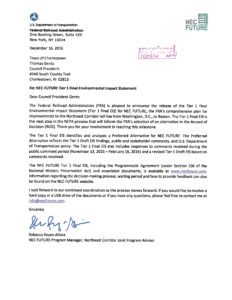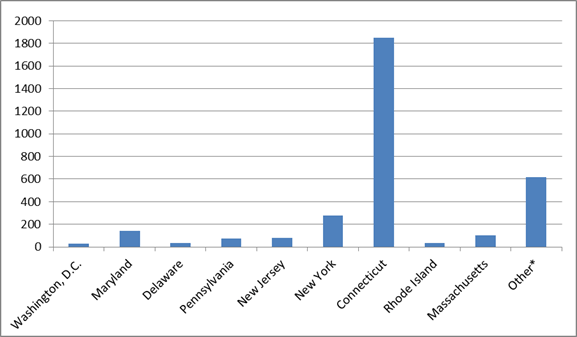The lack of data allows the FRA to grossly underestimate the human, environmental, cultural, and agricultural impacts
The following letter was submitted to NEC Future on the Tier 1 Final EIS and is shared with us here by the author Ruth Platner.
On December 18 2016, both the citizens and government of Charlestown Rhode Island first became aware of the NEC Future Tier 1 Final EIS and the plan to add a new section of rail through Charlestown. That notice came from members of the Charlestown Citizens Alliance (CCA) who had seen a television news story on December 16 about the plan’s impact on Providence, had then read the entire Final EIS, and published a story about the impacts on Charlestown.
The Town of Charlestown and other South County towns were not aware or involved in the scoping process that began in 2012, and we were not aware in any meaningful way of the Draft EIS or of any comment periods in 2015.
 On December 29, 2016, all towns in the North East Corridor received a form letter from the Federal Railroad Administration, dated December 16, announcing the availability of the Tier 1 Final EIS. The form letter gives no hint that the Plan has any relevance to or impact on Charlestown. Had the town not become aware of the impact on Charlestown from the CCA publication, the letter from the FRA might not have triggered a timely response. The receipt date of December 29 would have also reduced the time to respond by an additional 11 days. The timing of the release of the EIS during the Christmas holiday season when many are away also serves as an impediment to a response.
On December 29, 2016, all towns in the North East Corridor received a form letter from the Federal Railroad Administration, dated December 16, announcing the availability of the Tier 1 Final EIS. The form letter gives no hint that the Plan has any relevance to or impact on Charlestown. Had the town not become aware of the impact on Charlestown from the CCA publication, the letter from the FRA might not have triggered a timely response. The receipt date of December 29 would have also reduced the time to respond by an additional 11 days. The timing of the release of the EIS during the Christmas holiday season when many are away also serves as an impediment to a response.
Had someone followed the web link in the letter and searched the entire website for “Charlestown”, nothing would have come up except the same address on the letter included in the distribution list. After finding nothing for Charlestown, would they have then read through thousands of pages looking for a connection to Charlestown? Hard to know, but for towns outside of CCA’s distribution, there still seems to be no awareness.
The EIS, planning, and preliminary engineering etc., is prepared by Parsons Brinkerhoff/AECOM Joint Venture. It’s reported that $40 million has been spent so far on this planning process. How hard would it be to spend a few more pennies to write a letter stating that the plan includes “new rails and a new rail route in your community”. Or better yet, why not have included the towns in the scoping process from the very beginning?
The Tier 1 Final EIS is deficient with respect to impacts in Charlestown, and the entire EIS process from scoping in 2012 until and including the December 2016 release of the Final EIS has not followed the spirit of the National Environmental Policy Act (NEPA). These two are related as the failure to follow the spirit of NEPA and actively engage and collaborate with the affected community and local stakeholders has resulted in significant omissions in the natural and cultural resource data. The FRA’s use of incomplete data has resulted in gross underestimations of impact.
Charlestown is not named in any of the materials at the NEC Future website. The Town is impacted because it lies along the “Old Saybrook to Kenyon Bypass” where two new rails will be added in a new location. This bypass is described in Chapter 7.1, “New or Upgraded Segments”, as having the highest acreage’s of impact. As a town with these extreme levels of impact, the FRA should have ensured that Charlestown was engaged and involved from the earliest stages.
NEPA requires a scoping process that is the period in which the federal agency and the public collaborate to define the range of issues and possible alternatives to be addressed in the EIS. During the FRA scoping process, which started in February 2012, would have been the best time to engage the local towns and discover what parkland and natural, cultural, and agricultural resources existed in the Bypass area. Charlestown was not aware of the scoping process. Had the FRA made meaningful local contact at this time, they would have been introduced to The Nature Conservancy, the Westerly and Charlestown Land Trusts, the Wood Pawcatuck Watershed Association, the Charlestown Historical Society and others and the FRA would have benefited from much better data for their EIS. None of these non-profit stakeholders were contacted or notified.
Now the Tier 1 Final EIS has been published, the results of this flawed NEPA process are apparent in the documents. In the Charlestown area of the “Old Saybrook to Kenyon Bypass” the EIS has data omissions and erroneous decisions in every area. The lack of data allows the EIS to grossly underestimate the human, environmental, cultural, and agricultural impacts.
The same form letter that Charlestown received at the end of December was sent to the following other towns: East Providence, Pawtucket, Providence, Warwick, Cumberland, East Greenwich, Exeter, Foster, Glocester, Hopkinton, Johnston, North Kingstown, Richmond, Smithfield, South Kingstown, Westerly, Cranston, and Central Falls. At the draft stage these same towns got a similar form letter. Only Providence, Central Falls, and Pawtucket responded, but they received other forms of notice and promptings to help them gain awareness of the process.
Since CCA sounded the alarm on the FRA plan, citizens and the government in nearby Richmond have become aware that they would also be severely impacted by the FRA plan if the EIS is approved and the plan eventually implemented, yet they believe they were never noticed. East Greenwich is slated to increase from 2 to 4 rails through their town. That expansion, should it happen, will likely result in many real estate takings. There are no comments in the draft from East Greenwich. Do they know now? Stories like this exist all along the North East Corridor. Most communities still have no idea of the EIS process.
From Washington DC to Boston Massachusetts municipalities received these form letters. The FRA points with pride to the receipt of 3,200 comments at the draft stage. Those comments almost exclusively came from Connecticut where a group luckily discovered the plan and sounded the alarm.
The graph below appears in the Final EIS showing the state of origin of all comments. Do people in Connecticut really care more than all others, or were they just by chance the only communities informed?
Where there was not community engagement, which appears to be everywhere except Connecticut, it should be assumed that data on environmental and cultural impacts was not collected, and like Charlestown, the EIS has underestimated the impacts. Perhaps it is time to send a real message to these towns, one that explains what is at stake and what the future may hold if this plan is approved. Only then would the conclusions of this EIS have any chance of accurately predicting the impacts.
Visit Our Railroad Page For More On This Issue